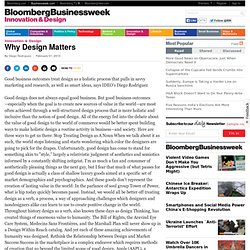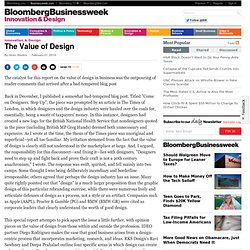

The Value of Design to Startups. Design and marketing are way more important than engineering for consumer Internet companies, argues angel investor Dave McClure Over the past five years I've consulted with and/or invested in about 50 startups.

I've gotten to know a lot of entrepreneurs and a fair number of the venture capital and angel investors who are backing these companies, most of which are in the consumer Internet field. And guess what? Probably more than half of the startups, and more than 90% of the investors, have no clue what they are doing when it comes to user experience and online marketing. So what, right? Design and marketing aren't just as important as engineering: They are way more important.
It's actually pretty easy to write a Web-friendly app or Web site these days. 2. Ten Ways to Measure Design's Success. Why Design Matters. Good business outcomes treat design as a holistic process that pulls in savvy marketing and research, as well as smart ideas, says IDEO's Diego Rodriguez Good design does not always equal good business.

But good business outcomes—especially when the goal is to create new sources of value in the world—are most often achieved through a well-structured design process that is more holistic and inclusive than the notion of good design. All of the energy fed into the debate about the value of good design to the world of commerce would be better spent building ways to make holistic design a routine activity in business—and society. Here are three ways to get us there: Stop Treating Design as A Noun When we talk about it as such, the world stops listening and starts wondering which color the designers are going to pick for the drapes. The Value of Design. The catalyst for this report on the value of design in business was the outpouring of reader comments that arrived after a bad-tempered blog post Back in December, I published a somewhat bad-tempered blog post.

Titled "Come on Designers. Step Up", the piece was prompted by an article in The Times of London, in which designers and the design industry were hauled over the coals for, essentially, being a waste of taxpayers' money. In this instance, designers had created a new logo for the British National Health Service that nondesigners quoted in the piece (including British MP Greg Hands) deemed both unnecessary and expensive. As I wrote at the time, the thesis of the Times piece was unoriginal and superficial—yet all too familiar. Design Factfinder. The value of design in business. Understanding the Value of Design. As a graphic designer, we’ll always appreciate well-educated and executed design.

We understand how much time goes into choosing the perfect font or why we went with the color palette we did. We see the value in our work and we take pride in what we do. We understand how design can be integrated into the larger picture and we can identify unsuccessful design when we see it. But, do your prospects / clients see the added value of effective, relevant design verses design lacking personalization? Especially those who are tentative to putting a little extra money forth for a “better product?”
Hiring a Designer is Like TV Shopping The above questions come natural to consumers. So what makes us choose the better brand over saving a few dollars? The Added Value of Design. The power of design and how to use it to achieve greater success in the marketplace is currently misunderstood and undervalued.

This paper discusses four principles that will help companies recognize the value of design in the 21st Century and how to successfully integrate it into a wider business strategy. The four concepts discussed are as follows: Design Identity, Design Strategy, Design Equity and Design Differentiation. DESIGN IDENTITY - The face of a company's brand and strategy Mission statements that provide direction and inspiration are becoming common practice within organizations. Compelling visions nurture cultural alignment, which in turn can lead to the development of a strong internal brand. Brands build power through consistency and awareness because contrary to popular belief, people like the familiar and the known of a relationship. A clear and strong design identity can represent what an organization wants their brand to stand for now and in the future.
Notes: The link between creativity and effectiveness in advertising.